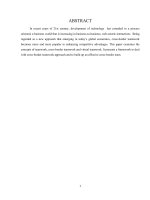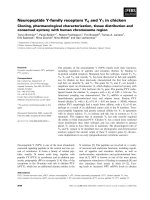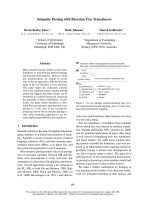Dealing with cross-border teamwork approach.doc
Bạn đang xem bản rút gọn của tài liệu. Xem và tải ngay bản đầy đủ của tài liệu tại đây (203.08 KB, 22 trang )
ABSTRACT
In recent years of 21st century, development of technology has extended to a process oriented,
e-business world that is increasing in business-to-business, web-centric interactions. Being regarded
as a new approach that emerging in today’s global economics, cross-border teamwork becomes more
and more popular in enhancing competitive advantages. This paper examines the concepts of
teamwork, cross-border teamwork and virtual teamwork. It presents a framework to deal with cross-
border teamwork approach and to build up an effective cross-border team.
1
INTRODUCTION
It can be said that globalization has been one of the most hotly-debated topics in international
economics over the past few years. Unprecedented changes in communications, transportation, and
computer technology have given the process new impetus and made the world more interdependent
than ever. Multinational corporations manufacture products in many countries and sell to consumers
around the world. In this global prospect, working as team is not only a trend but also meeting work
requirement. The term “teamwork” or “cross-border teamwork” is becoming more and more popular
in every organization, enterprise and company. Cross-border teamwork is particularly important in
global business management. Globalization creates global firms with many subsidiary that differ in
culture, time zones and attitudes, communication and management styles, organizational learning and
knowledge management, international negotiations, international business strategy, virtual teams, and
human resource management issues.
In the field of human resource management, building an effective teamwork, especially an
effective cross-border teamwork, will help companies to improve competitive advantages and meet
requirements of globalization process.
People in every workplace talk about building the team, working as a team, but few understand
how to create the experience of team work or how to develop an effective team.
To understand more about forming and developing a team as well as a cross-border team, this
paper will focus on 3 main parts as follows:
Part 1: Overview of teamwork
Part 2: Dealing with cross-border teamwork approach
Part 3: Building an effective cross-border teamwork
2
1. Overview of teamwork
1.1.Approach of teamwork
Being aware of the current swift changes in the business environment, foremost on the global
stage, one surely has to underline the growing importance of teams. Keeping in mind this new focus in
the world of business, commonly described as globalization (Foa, Roberto, 2004), individual skills or
self – reliance are in many cases not sufficient to keep up with today’s demand. This obviously
implies the universally accepted notion that teams in general outperform individuals (See Mooney,
Ann C.,2001). In line with this observation Katzenbach and Smith in their widely acknowledged
publication on the advantages of teams put it bluntly as “people so committed to something larger than
themselves” (Katzenbach, Jon R., Smith, Douglas K.,1993).
Team is defined as a group consisting small number of people with the complementary skills
who are committed to some common purpose, performance goals, and the approach for which they
will hold themselves mutually accountable (Publicguideworld.com, Teamwork).
When a person has all the talents and the enthusiasm in the world and yet he doesn’t have free
time to work, it all turns out useless. Availability of every member is very much needed to work as a
team. If no one’s there, who do you expect to pursue the team’s goals? This work-ability is not all
about free-time, however, it also entails a large amount of adaptability. Every member must be able
to expect different possibilities and must know how to react on them should they arise in the course
of events.
Understanding among team members is a necessity in every team for every member to be able
to work in the best of his abilities. Everyone must be open to new ideas and suggestions. Everyone
must have the capability to understand people. It is in keeping the communication lines open that
the team can more efficiently achieve its goals.
Every team member must be able to practice respect so that he can expect to be respected in
return. A team could discuss things and every member could voice out his own opinion in whatever
matter they are discussing without degrading his teammate or his teammate’s suggestions no matter
3
how irrational they are. It is one thing to listen and be able to humbly object and it is another thing
to just avoid to listen. Whenever a team is brainstorming, everyone must be able to raise his
opinions without having any hard feelings.
1.2.Advantages of teamwork
As we mentioned above that working as team is not only a trend but also meeting work
requirement in the globalization context. We should also know that there are several advantages of
teamwork.
Pooling knowledge and resources is one of teamwork benefits. In a team with lots of members,
members may be from different apartments of the same company, they have different expertise, in
such team, members can be free to show their special knowledge, and diversity of information can
be provided in the team. It will save much more time to find the resources than individual work.
Teamwork also helps diversify skill and experiences in workplace. Every member is specialized
in one field. A good organization is really needed in proper distribution of work. The best member of
any group is he who demands work based on what he can do. It is every group member’s
responsibility to ensure that everyone has a work to do and that everyone is always the best man for
his job.
A combination of strengths -especially if the team has been chosen carefully, it can get a good
range of abilities, fields of expertise and personality types, so for every situation there should be at
least one person who can deal with it.
A range of opinions - if "two heads are better than one," six can be better still - a group meeting
is often very useful for ironing out flaws in a plan, testing it out, spotting pitfalls etc. “The bigger
picture drives your actions; your function exists to serve the bigger picture”(Cited by Susan M.
Healthfield, About.com)
4
Divided responsibility - while ultimate responsibility rests with the team leader, not much can be
achieved without an effective team. The team structure allows those who have strengths in a particular
area to take more responsibility for that area.
Team spirit - a good team, well led, creates loyalty in its members. Not wanting to let your team-
mates down can be a powerful motivating force, as can the sense of pride in being part of a successful
group.
Building a team-oriented environment contributes to the overall success of the organization. In
this environment, one works with fellow members of the organization to produce these results. Even
though one has a specific job function and belongs to a specific department, he or she is unified with
other organization members to accomplish the overall objectives.
It is necessary to differentiate this overall sense of teamwork from the task of developing an
effective intact team that is formed to accomplish a specific goal. People confuse the two team
building objectives. This is why so many team building seminars, meetings, retreats and activities are
deemed failures by their participants. Leaders failed to define the team they wanted to build.
Developing an overall sense of team work is different from building an effective, focused work team
when considering team building.
2. Dealing with cross-border teamwork approach
2.1.Key issues for understanding cultural differences
Globalization context requires multicultural knowledge to achieve business results. To lead
successfully across borders and cultures, it is imperative to understand differences in cultural values,
and their influences on everyday business practices. Key issues covered include: a deeper
understanding of differences in values, behaviors and attitudes, and their practical implications for
leading successfully across borders and cultures.
The first problem in dealing with cross-border teamwork approach is Culture. It needs to have a
general view of general culture, national culture and organizational culture.
5
Culture is defined as a pattern of beliefs and expectations shared by the organization members.
These beliefs and expectations produce norms that powerfully shape the behavior of individuals and
groups in the organization (Schwartz and Davis, 1981).
It can be said that culture is the concept we use to explain seemingly patterned behaviors from
the perspective of a social group. Culture is the complex matrix of behavior; a shared system of valued
sensibilities and practices which influence individuals’ habitual ways of saying and doing things.
Culture is all the things taken-for-granted and presumed as a basis for communication. Culture refers
to the usual ways of doing and saying. Culture is the common sense in situations and their affairs and
activities. People spend all their time learning how and why to act, learning what emotion goes with
what cognitive affair, learning how to use language, how to see things, hear things, and touch things,
learning things so well that they become habits of experience.
Every nation has its own national culture. The concept of cultural nation poses one of the major
problems in the humanities since there is no consensus how to define it. A base line would be to say
that the members of a cultural nation are aware of constituting an ethical-political body together,
which is differentiated from others by the members sharing a number of defining cultural features.
Those features can include language, religion, tradition, or shared history. All this can be taken as a
sign of a historically evolved distinct culture. The question whether a nation needs to have an
associated territory is subject of debate. (En.wikipedia.org, Nation).
Each organization has its own distinctive culture, which combined from strategy, leadership,
history, size and human. It would be said that culture is an important factor that represents the
image of one corporate, and it creates the tradition or “the way we do things around here” (Deal and
Kennedy, 1982). There are many researches about corporate culture including Geert Hofstede’s
theory, which defines culture as the “collective programming of the mind which distinguishes the
members of one group or category of people from another” (Hofstede, 1991). He stated that culture
does not belong to any individual, but to groups.
Cross-cultural communication (also frequently referred to as intercultural communication, which
is also used in a different sense, though) is a field of study that looks at how people from differing
6
cultural backgrounds communicate, in similar and different ways among themselves , and how they
Endeavour to communicate across cultures (En.wikipedia.org, Cross-cultural communication).
Effective teams have at least two common characteristics. First character is individuals'
behavioral styles and skills are complementary. The second is individuals are aware of how cultural
differences affect cooperation and interactions. This knowledge will enable team members to work
together to assimilate into new teams and quickly become effective. In today's multicultural business
environment, high-performing multicultural teams can out-perform homogeneous teams when their
diverse skills and contributions are maximized (Hodge-ia.com, Cross-cultural business skills).
Although human resources departments are becoming increasingly supportive of cross-cultural
training for expatriating employees and their families, the effectiveness of this training has not kept
pace with the increasing demand for practical, performance-related knowledge and skills. As
business becomes more competitive, expatriating employees must become competent in working
and managing in the new culture. We need to raise the bar; instead of generalities, cross-cultural
training must be tied to improving performance and bottom-line results.
2.2.Dealing with Time Zones
Time difference is another problem in dealing with cross-border teamwork approach. Time
becomes a problem when people who are not in the same place and need some of their activities to be
synchronized. When working with different time zones, individuals can be a day behind of getting
something done. Time zones need to be kept in mind when trying to stay connected with someone
from another country.
The time difference becomes a greater concern as the distance between the teams grows. We
have different time zones all over the world and it may be difficult to get everybody on the right time.
It may be midnight in one part of the world and it may be the rush hour in another business. This is a
problem because everybody needs to be on the same page and doing the same thing. One may not
desires to schedule one team meeting during regular business hours and the other team meeting at 2
a.m. Anytime that a communication for instance needs to be immediately connected to Asia countries
from the United States, users will have a hard time to obtain communication because it will be a
7
different time in Asia countries and people will probably be asleep and not receive the intended
communication in time. The time difference makes it hard on cross-border teams but is still an
obstacle that can be overcome.
2.3.Communication
One obvious problem that can arise is communication in different language barriers. People in
different countries have different languages. One of the main problems in dealing with cross-border
teams is the difference in languages that are spoken.
When the team members speak different languages they have trouble in communicating. Many
things could go wrong if clear communication is not initiated then many problems could occur in such
things such as orders, measurements, and prices. The language problem can be somewhat difficult to
overcome if a common language is not agreed upon. The major languages used in businesses today
are English, Spanish, Japanese and Chinese. If a common language can be agreed upon in advance,
this problem can be alleviated. The language barrier is a small problem but will be overcome if
management selects their cross-border team members with great care.
Communication is a major challenge because of different cultures among team members.
However, it may be not necessary for communication to be the same when we match teams in a multi-
cultural environment. Clearly transferring information among team members is main problem to deal
with. Because many of these members reside in different time zone areas, it is a “rule of thumb” to
be precise in what each member wants to know and how well they ask a question. If team members
phrase their questions carefully the first time, they will get their point across successfully without
having to deal with sending changes and making up for the time lost (Alexander 2000). Writing
clearly and not using acronyms is another way to deal with this issue.
Advances in technologies have increased each person’s ability and likelihood of interacting with
people of cultural backgrounds quite different from their own. According to Visions Inc,
“Multiculturalism is a process of change by which we learn to recognize, understand and appreciate
cultural identities, as well as the similarities and differences of people from other cultural groups.”
8









